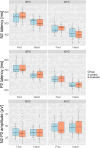The heating rate matters! contact heat evoked potentials in musicians and non-musicians
- PMID: 40551881
- PMCID: PMC12183249
- DOI: 10.3389/fpain.2025.1555034
The heating rate matters! contact heat evoked potentials in musicians and non-musicians
Abstract
Classical musical training requires extreme levels of fine motor control, resulting in adaptive neuroplastic alterations in professional musicians. Additionally, musicians have a high prevalence of pain syndromes, which makes them an interesting group to research the influence of neuroplasticity on nociception. This report consists of two parts. Firstly, we present the results of a preliminary study comparing musicians and non-musicians with respect to their cortical responses to noxious heat stimuli at their hands and feet, using contact heat evoked potentials (CHEPs). Secondly, we quantitatively discuss the influence of the heating rates of two different stimulation devices on CHEPs when applying the exact same settings. For this, we measured the temperature curves of the devices' stimuli and connected their respective heating rates to the resulting CHEPs. Musicians showed a significantly larger latency difference between hands and feet (20.86 ms, ), compared to non-musicians. Additionally, we found that, despite the exact same settings, different stimulation devices produced considerably different temperature curves. The resulting time difference between the stimulation devices of 104.78 ms explains the latency difference of the CHEPs produced by the respective device of 104.09 ms extremely well. This study underlines that musicians are an interesting model for neuroplasticity regarding nociception, as they respond differently to nociceptive stimuli. Moreover, it contributes to the understanding of the connection between a stimulation device's heating rate and the resulting CHEPs, an important finding that has never been quantified before but has considerable consequences on the comparability of results.
Keywords: CHEPS; EEG; heating rate; music; neuroplasticity; nociception; pain.
© 2025 Sternkopf, Scheuren, Jutzeler and Lee.
Conflict of interest statement
The authors declare that the research was conducted in the absence of any commercial or financial relationships that could be construed as a potential conflict of interest.
Figures



Similar articles
-
Systemic pharmacological treatments for chronic plaque psoriasis: a network meta-analysis.Cochrane Database Syst Rev. 2017 Dec 22;12(12):CD011535. doi: 10.1002/14651858.CD011535.pub2. Cochrane Database Syst Rev. 2017. Update in: Cochrane Database Syst Rev. 2020 Jan 9;1:CD011535. doi: 10.1002/14651858.CD011535.pub3. PMID: 29271481 Free PMC article. Updated.
-
Survivor, family and professional experiences of psychosocial interventions for sexual abuse and violence: a qualitative evidence synthesis.Cochrane Database Syst Rev. 2022 Oct 4;10(10):CD013648. doi: 10.1002/14651858.CD013648.pub2. Cochrane Database Syst Rev. 2022. PMID: 36194890 Free PMC article.
-
Systemic pharmacological treatments for chronic plaque psoriasis: a network meta-analysis.Cochrane Database Syst Rev. 2021 Apr 19;4(4):CD011535. doi: 10.1002/14651858.CD011535.pub4. Cochrane Database Syst Rev. 2021. Update in: Cochrane Database Syst Rev. 2022 May 23;5:CD011535. doi: 10.1002/14651858.CD011535.pub5. PMID: 33871055 Free PMC article. Updated.
-
How lived experiences of illness trajectories, burdens of treatment, and social inequalities shape service user and caregiver participation in health and social care: a theory-informed qualitative evidence synthesis.Health Soc Care Deliv Res. 2025 Jun;13(24):1-120. doi: 10.3310/HGTQ8159. Health Soc Care Deliv Res. 2025. PMID: 40548558
-
Intravenous magnesium sulphate and sotalol for prevention of atrial fibrillation after coronary artery bypass surgery: a systematic review and economic evaluation.Health Technol Assess. 2008 Jun;12(28):iii-iv, ix-95. doi: 10.3310/hta12280. Health Technol Assess. 2008. PMID: 18547499
References
LinkOut - more resources
Full Text Sources

